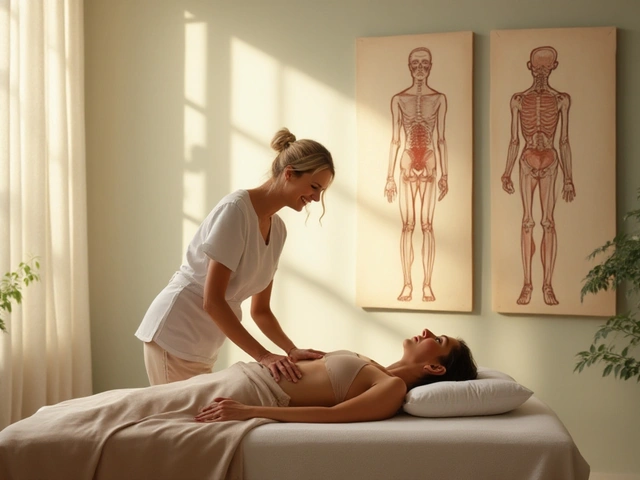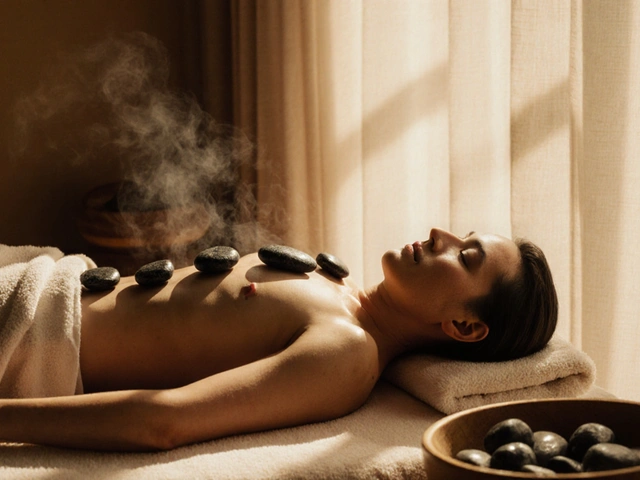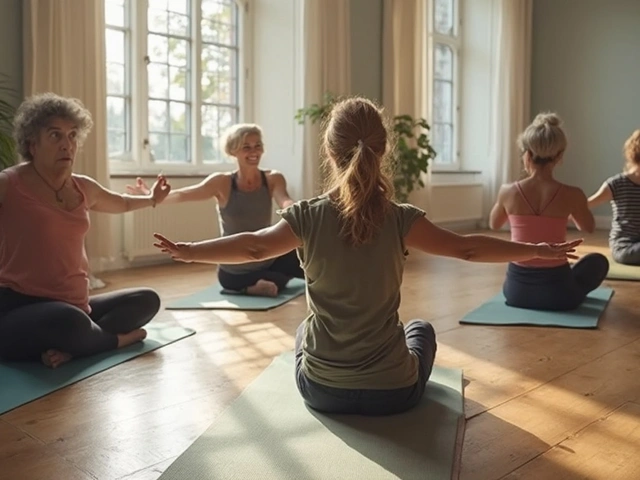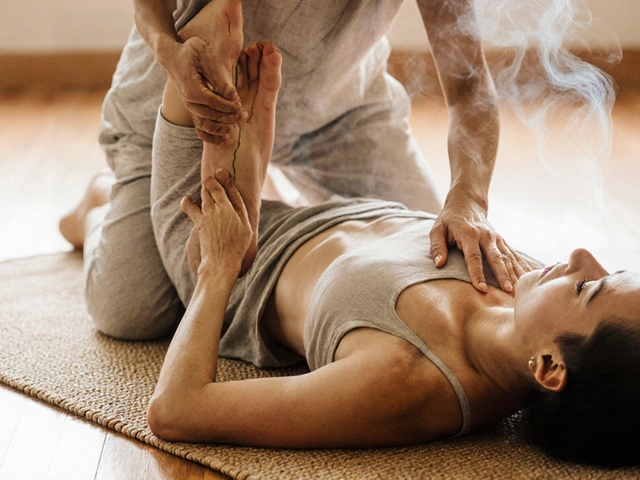Acu-Yoga for Beginners: Integrating Acupuncture with Yoga Practices

Imagine merging the ancient wisdom of yoga with the precise science of acupuncture. That's Acu-Yoga. This innovative practice combines yoga postures with pressure points used in acupuncture to enhance health and wellness. Perfect for those just starting out, it opens up a new dimension to achieving peace and balance in life.
Acu-Yoga isn't just about physical postures; it's about unlocking energy flows within the body to combat stress, enhance circulation, and boost overall vitality. By applying gentle pressure to specific points during various yoga poses, this practice maximizes the health benefits of each posture.
- What is Acu-Yoga?
- Health Benefits
- Essential Practices
- Setting Up Your Space
- Common Acu-Yoga Poses
- Safety Tips
What is Acu-Yoga?
Acu-Yoga is a compelling synthesis of two powerful traditional practices: yoga and acupuncture. At its heart, it seeks to unify the flexibility and meditative elements of yoga with the targeted therapeutic impact of acupuncture’s meridian system. In essence, practitioners perform specific yoga poses designed to activate and alleviate meridian points on the body, which are believed to be vital energy paths influencing physical, emotional, and mental health.
The roots of Acu-Yoga trace back to ancient times, yet it remains fundamentally grounded in contemporary wellness approaches. Yoga, which originated in India over 5,000 years ago, offers a systematic practice involving postures (asanas), breathing techniques (pranayama), and meditation to enhance bodily and mental health. Acupuncture, on the other hand, hails from traditional Chinese medicine and involves stimulating certain points on the body, typically with needles, to alleviate pain and treat various health conditions.
By combining these practices, Acu-Yoga provides a non-invasive means to health that leverages the self-healing capabilities of the body. Practitioners often experience enhanced relaxation, greater flexibility, improved energy levels, and a significant reduction in stress. It particularly advocates for self-care, urging individuals to engage actively in their journey towards health and wellbeing.
During a typical Acu-Yoga session, individuals might hold a yoga pose while applying pressure to acupoints either with their fingers, or sometimes with the help of props like balls or foam rollers. This dual action aims to simultaneously enhance the yoga benefits by increasing the flow of chi, or vital energy, through the body’s energy pathways, making each pose not only a physical exercise but also a healing ritual.
Understanding Energy Pathways
In both acupuncture and Acu-Yoga, the concept of energy pathways, or meridians, is central. These meridians are channels that carry life energy (chi) throughout the body and are crucial for overall health. Each meridian corresponds to different organs and functions within the body, influencing everything from emotional well-being to physical health. Acu-Yoga poses are meticulously designed to align these meridians, promoting a harmonized flow of energy which optimizes bodily functions and fosters a sense of deep internal balance.
Health Benefits of Acu-Yoga
Acu-Yoga stands out as a beacon of holistic healing, skillfully marrying the disciplines of yoga and acupuncture to promote health and wellness. At its core, Acu-Yoga aims to enhance the natural energy flows within the body, known as Qi in Chinese medicine, which is believed to be vital for maintaining health and fighting diseases. This practice leverages yoga's ability to improve flexibility, strength, and balance, while acupuncture's influence on energy meridians aids in relieving pain and promoting healing processes.
Studies suggest that the integration of these two practices can dramatically improve stress management. The soothing poses combined with strategic pressure help release tension from the muscles and calm the mind, leading to significant reductions in stress levels. This can be particularly beneficial for those who deal with high-pressure environments or chronic stress situations. Moreover, Acu-Yoga has been noted for its effectiveness in enhancing sleep quality, helping individuals to fall asleep faster and improve the duration and quality of their sleep.
On the physiological front, Acu-Yoga can boost cardiovascular health by improving heart rate variability and reducing blood pressure. This is crucial for long-term heart health and can prevent various cardiovascular diseases. The practice also enhances respiratory function and efficiency, making it a valuable exercise for those suffering from respiratory conditions or those looking to increase their lung capacity. Furthermore, the gentle stretching and muscle activation involved in Acu-Yoga improve circulation, ensuring that oxygen and nutrients are efficiently distributed throughout the body.
Not to overlook, Acu-Yoga also supports mental health by fostering a deeper connection between mind and body. The meditative aspects of yoga, combined with the therapeutic touch of acupuncture points, facilitate a profound mental clarity and emotional stability. Participants often report a noticeable improvement in mood, reduced anxiety levels, and a greater sense of overall well-being. This dual practice teaches participants how to harness their inner strength and use it to combat the mental challenges of everyday life.
The list of health benefits is underpinned by testimonials and experiences of practitioners worldwide. Many have found that regular sessions have not only helped in healing physical ailments but also in crafting a more resilient mental and emotional state. For instance, a practitioner shared their experience in a recently published health magazine:
"Through Acu-Yoga, I've discovered a powerful way to align my body's energies. It has profoundly transformed my approach to health and wellness, providing relief from chronic migraines and improving my emotional resilience."
In conclusion, the myriad health benefits of Acu-Yoga make it a compelling practice for anyone looking to enhance their physical and mental health. Its unique combination of yoga and acupuncture offers a refreshing approach to traditional wellness techniques, making it suitable for individuals of all ages and fitness levels.
Essential Practices
Delving into Acu-Yoga might sound complex at first, but with a few essential practices, you can embark on this journey smoother and more effectively. The secret lies in understanding how yoga poses align with acupuncture points, further enhancing the movement of energy or 'Qi' throughout the body. Each practice integrates awareness with breathing and precise postural alignments to target specific energy pathways known as meridians.
Beginner practitioners of Acu-Yoga should always start by understanding the body's meridian lines. These are paths through which life-energy flows and are central to both yoga and acupuncture. By incorporating a focused approach on these lines while performing yoga poses, one can attain an enhanced therapeutic effect aimed at specific health concerns like digestive health, mental clarity, and stress reduction.
The use of guided visualizations is also common in Acu-Yoga to deepen the mind's role in healing and energy flow. During your sessions, visualize energy flowing freely throughout your body, unlocking and energizing blocked areas. This meditative component not only uplifts your spirit but also reinforces the physical benefits by promoting relaxation and stress management.
Proper breathing techniques, such as pranayama, play a crucial role in any yoga practice, but in Acu-Yoga, they serve the dual purpose of enhancing oxygen flow and aiding in the stimulation of meridian points. Activities like slow, deep breathing help in maintaining focus and amplifying the impact of each pose with precision to where pressure points are addressed.
Posture alignment is vital in Acu-Yoga. Striking the right pose is not just about form but meeting the therapeutic touch to the exact meridian points. For instance, a well-aligned Cobra Pose can, beyond stretching the back, aid heart meridian points, potentially offering relief in emotions and heart functionality. It's about quality, not just quantity, in every movement you perform.
If you're venturing into Acu-Yoga, always consult with a trained professional who can guide you to not only perform the poses correctly but also educate you on the pressure points. Their expertise can be instrumental especially when tailoring a routine that meets specific personal health goals. Under guided supervision, you’ll ensure safety and maximize the benefits of your practice. This blend of insightful instruction and personal effort can remarkably transform your Acu-Yoga experience.
Setting Up Your Space
Creating the right environment for Acu-Yoga is as vital as the practice itself. Think of your practice space as a sanctuary where stress and daily disturbances cannot reach you. First and foremost, the area should be clean and clutter-free. Physical clutter can lead to mental clutter, which is counterproductive in a practice that aims to foster clarity and calmness. Ensure the floor is even and there is enough room to move freely in all directions without bumping into furniture. This not only makes practicing safer but also more enjoyable.
Lighting plays a significant role in setting the right mood. Natural light is preferable as it not only brightens the space but also provides vitamin D, which is beneficial for your mood and health. If natural light isn't abundant, warm, soft artificial lighting can be used instead. Keep the room temperature comfortable; too hot or too cold can distract from your focus and affect the effectiveness of your practice. Adding plants can improve the air quality, and their presence has a soothing effect, enhancing the tranquil atmosphere you want to achieve.
Consider the acoustics of your space. If you are in a noisy environment, it may be helpful to use sound-cancelling elements like thick curtains or wall fabrics, which can absorb disruptive noises. For those who enjoy guided sessions or calming music during their practice, a good sound system is essential. Be mindful of the decor as well. Decorative elements should be minimal and can include items like a simple statue of Buddha, a few candles, or an essential oil diffuser to introduce a gentle, soothing aroma that can aid in relaxation and concentration.
Finally, your Acu-Yoga space should be a no-technology zone to fully disconnect from the digital world and connect with oneself. This helps in deepening your practice and enhances mindfulness. Every element of your space should contribute to a calm and peaceful environment conducive to healing and self-discovery. When the external environment aligns with your internal intentions, the benefits of Acu-Yoga are greatly magnified.
Common Acu-Yoga Poses
Engaging in Acu-Yoga requires not only an understanding of yoga but also a rudimentary grasp of where the body's acupressure points are located. Together, these elements form a synergistic blend that substantially enhances relaxation and health. Let’s explore some popular poses that are widely practiced in Acu-Yoga. These poses are designed to be beginner-friendly and focus on activating specific meridians that are key to our body's energy flow.
One of the essential poses is the Modified Child’s Pose. This pose targets the spine and the bladder meridian that runs along it. By gently resting your forehead on the ground, and extending your arms forward, you can activate these points. The additional modification involves applying slight pressure with the fingertips to the areas near the base of the spine, enhancing the release of any blockages along the meridian.
Butterfly Pose with a Twist
Another beneficial pose is the Butterfly Pose but with an added twist to incorporate acupressure. As you bring the soles of your feet together and let your knees fall gently to the side, consider applying gentle pressure to the inner ankles. This area is significant in Chinese medicine as it houses points related to the spleen and kidney meridians, pivotal for energy distribution and hormonal balance. This subtle adjustment in the traditional pose allows a reinvigoration of energy flow throughout the body.Next is the Seated Forward Bend, where meticulous attention is paid to the pressure points on the legs. As you stretch forward, maintaining a flat back and reaching for your toes, use your thumbs to apply gentle pressure on the calves. This action stimulates the stomach meridian points located on the lower leg, promoting digestion and alleviating abdominal discomfort.
Additionally, practicing the Dragon Pose can profoundly impact your liver meridian, crucial for detoxification and blood flow. While in this deep lunge, focus on deep breathing and press your palms into the ground beside your front foot, activating the liver points that run through the thighs. This pose is exceptional for those seeking to reduce stress and ease the emotional imbalance.
Finally, it’s essential to be attentive to your body’s responses during these exercises. Make sure movements are smooth, and breathing is guided and thoughtful. Listen to your body and adjust the pressure applied according to your comfort level. Each of these poses, when done correctly, can bring a noticeable improvement in energy levels and contribute positively to physical and mental health.
Safety Tips
When beginning a journey into Acu-Yoga, safety must be a priority. Although Acu-Yoga is generally safe, combining yoga with the stimulation of acupuncture points brings its unique set of considerations. First, it's crucial to understand your body's limits and be aware of any pre-existing conditions that might affect your ability to perform certain yoga poses or pressure point stimulations. It's advisable not to push yourself into discomfort or pain, as the essence of Acu-Yoga is to promote health and healing, not to strain the body further.
Before practicing Acu-Yoga, consulting with a healthcare provider is essential if you have any serious health issues, especially those related to the musculoskeletal or nervous systems. Certain conditions, such as pregnancy, cardiovascular issues, or severe osteoporosis, may require modified poses or specific precautions to ensure safety. Engaging with a trained Acu-Yoga instructor who can guide you through the process with attention to your individual health profile is always a smart decision.
While practicing the poses and applying pressure to acupuncture points, maintaining a balanced and stable environment is important. Ensure that the surface you practice on is flat and non-slip to prevent any falls or injuries. Using yoga mats or padded surfaces can provide additional safety. Also, wearing comfortable clothing allows for unrestricted movement and easier access to acupuncture points.
In the context of self-applied pressure, it's crucial not to overstimulate the points. The idea is to apply gentle pressure that feels firm yet not painful. Overstimulating can lead to bruising or increased soreness, which is counterproductive. To avoid such issues, applying pressure in gradual increments and checking in with your body's response is vital. Listen to your body and respond to its needs, adjusting the pressure accordingly.
Lastly, hydration plays an important role in any physical activity, including Acu-Yoga. Keeping your body well-hydrated aids in muscle function and overall energy levels, ensuring that your body can handle the poses and pressure application effectively. So, always remember to drink plenty of water before, during, and after your practice to maintain optimal body function.
By keeping these safety tips in mind, your Acu-Yoga sessions can be both beneficial and enjoyable, helping you achieve better health without compromise. It's about harmonizing body and mind, so allow yourself to enjoy each session with the reassurance that you are practicing safely.





